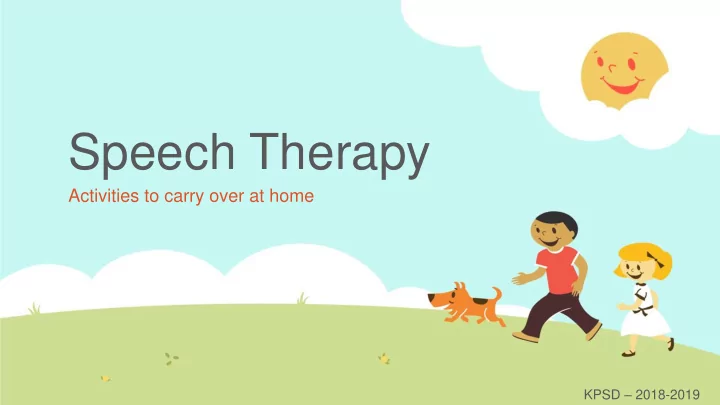

Speech Therapy Activities to carry over at home KPSD – 2018-2019
Welcome! Introduction of Speech Language Pathologists (SLP) Parent Forum Agenda What will happen his year Today’s topic: Recommendations for Speech -Language Therapy at home
Routines Routines such as getting dressed, washing dishes or cleaning up a room allow for consistent practice. Very easily added prepositional words such as “in, out, on, off, over and under”. You can also play with the routine by forgetting things or doing them wrong and see if the child will attempt to correct and then use those prepositional words Narrate daily activities and play Bath time: a great time to work on body parts, describe the toys in the bathtub, the water is warm, the bubbles are white, the washcloth is pink, etc. Getting dressed: Talk about the colors of the clothes, the weather outside, the clothes you need “You’re wearing your red sweatshirt because it’s cold outside!”
Books Reading helps build communication skills like auditory comprehension, expressive vocabulary, memory, and word knowledge. Children with speech and language problems may have trouble sharing their thoughts with words or gestures. They may also have a hard time saying words clearly and understanding spoken and written language. Reading to your child and having her name objects in a book to read aloud to you can strengthen her speech and language skills. Tips for reading: Read the same story over and over again Choose books with rhymes or songs Point to pictures and talk about them Talk about events from the story that relate to your child’s life Ask your child questions Make it fun! – have your child “read” the book
Toys LIMIT SCREEN TIME Bath toys : discuss action words such as pour, swim, float, sink Music toys : Sing familiar songs, discuss words such as fast, slow, loud, soft/quiet, go, stop. Use things on hand such as pots and pans, spoons, Tupperware, paper towel tubes Cars : Routine phrases like “Ready, Set, Go!”, fast, slow, up, down, around, crash Farm toys : imitating animal sounds, following directions, positional concepts such as in/on/under/behind/out Kitchen/food toys : colors, shapes, sizes, more, less, asking questions, taking orders. Use supplies on hand such as measuring cups, rice or water, muffin tins, play-doh Dress up – use your imagination! Use hats to become a cowboy, a police officer, firefighter, etc. Roll play with questions/comments, ask “where” questions Dolls : Label clothes, body parts, pretend to go through daily routines and use the appropriate language. Building toys : blocks, play-doh, clay. Action words like roll, smush, squeeze, drop. Describe it by feel, smell, color. Most importantly: Have fun and model appropriate play!
Activities Songs/fingerplays: Old McDonald, Itsy Bitsy Spider, Twinkle Twinkle, Peek-a-boo Nature walk – walk around your neighborhood. Point out things you can see, smell, hear, feel. Find things that begin with target sounds. Collect leaves in the fall. Dramatic play – pretend! Cooking – allow kids to be involved in cooking. Discuss what you are doing, what’s next, measurements, actions you are performing (measuring, mixing, putting in, taking out).
Here are some things to remember…
Attention Joint attention Also called “Shared attention” When two individuals focus on one object and there is an understanding between the two people that they are both interested in the same object or event Create joint attention: Look at object you want your child to focus on Point to the object Show the object Verbally name the object Why? Joint attention provides the foundation for social, cogitative, and language development.
Repetition and Expansion Repetition: Saying the same thing over and over again. This provides a good model for children to then imitate. If your child says a word incorrectly, repeat back the idea in the correct way. For example: Child says “I heared a dod ” you can repeat back “Oh, I hear the dog !” Expansion: When your child speaks to you, repeat what the child said and then expand upon it For example: Child points to animal and says “dog” the adult expands “I see the dog” “There is a little dog” “The little dog is over there” “Do you hear him barking?” Repeat the same words or phrases every time we play a game Makes it easier to understand and then say words Child will anticipate what comes next Use facial expressions and gesture when we talk Makes it easier for children to understand and learns a way to express themselves without just words
Types of talk Parallel Talk: Adult will describe the child actions. Example: “You’re eating your chicken” Self Talk: Adult will describe their own actions. Example: When setting the table say something such as “I am setting the table”
Questions Reduce the number of questions you ask your child. Children speak more freely if they are expressing their own ideas rather than answering an adult’s questions. Instead of asking questions, simply comment on what your child has said, thereby letting them know they have been heard Ask open-ended questions during play “What are we making?” “What should I do?” “What are you doing?” Don’t do all the talking / Be a Responsive Partner OWL Observe – Recognize child’s feelings and needs, body language, face etc. Wait – Give child a chance to express themselves Listen- Encourages child to express themselves
Thank You Questions?? Comments?? What would you like to know?
References Joint Attention and Social Referencing – Valley CoPA – November 2007 “Strategies to Help Your Child Talk: Using Expansions and Extensions – www.playingwithwords365.com A Speech Therapist’s Guide to Reading with Your Child – www.speechpathways.ca Reading Together: Tips for Parents of Children with Speech and Language Problems
Recommend
More recommend